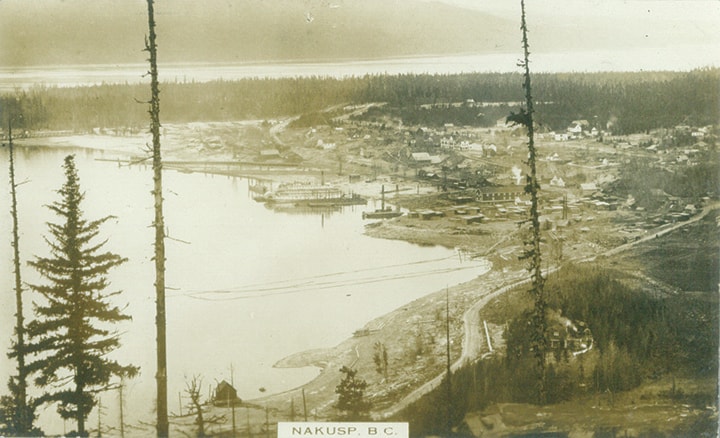Nakusp is among the few surviving local place names derived from a Sinixt First Nation word, and in a fairly unadulterated form no less, but there’s some doubt about its meaning.
It was first mentioned in 1889 by George Dawson in his Report on a Portion of the West Kootanie [sic] District, British Columbia: “Another stream of comparatively small size, flowing in one mile and a half south of the last, is known as the Na-kusp. It comes from a low and rather wide valley which is reported to be used by the Indians as a pass to Slocan Lake.”
It next shows up in the Nelson Miner of Dec. 12, 1891: “[T]he railway will be extended along the east shore of Upper Arrow lake to the mouth of Na-kusp creek …”
The present spelling first appears in the Miner on Jan. 9, 1892: “[T]here is great rivalry between the parties interested in the Kaslo creek and Slocan river routes, to say nothing of the route the people of Revelstoke will open by way of Nakusp creek.”
Capt. James W. Troup was quoted in the Spokane Review of Feb. 9 as stating: “[T]he new town which the Canadian Pacific are laying out at the mouth of Na Kusp creek … will probably be called Kootenai City, though it may be called Slocan …”
On May 21, the Miner asked: “Should the name of the new town be Nakusp or Napusk? Those who have located there claim the latter is correct.” On June 18, the paper added: “[T]he small controversy about the name of the creek is settled. The Colville Indians say that Na Kusp (pronounced Na Koosp) means long point, whereas Napusk means nothing.”
The Nakusp post office opened on Aug. 1, 1892. The townsite was laid out by A.E. Hodgins and Frank Fletcher and deposited with the land registry on Jan. 28, 1893.
In the Arrow Lakes News of Oct. 14, 1927, T.J. Barron wrote of the name’s origin: “About three years ago, I interviewed Chief Louis. He stated definitely that the name ‘N’oosp’ had been given to the spot at the mouth of Nakusp Creek. He said that the word means a place where the water forms an eddy or whirl, and suiting his gestures to the explanation, he made a whirling motion with his hand.
“He stated further that the Indians had given the name to that particular spot only, and that the whites had extended it to the town and neighborhood. He also said that ‘Nakusp’ was not the correct form of the word; that the white men had inserted the ‘k’ because they could not pronounce the Indian word. I asked him to pronounce it for me, which he did several times — ‘N’oosp’ — dwelling on the ‘n’ and sounding the ‘oo’ like ‘oo’ in the word good.”
In Pioneer Days of Nakusp and Arrow Lakes (1952), Kate Johnson quoted Frederick W. Jordan, who “oft told the story of asking Chief Indian Louie how Nakusp got its name. Chief Louie was holding a Big Chum tobacco bag in his hands at the time and this is the answer he gave: ‘Indians come down lake in canoes, storm very bad, canoes nearly lost at Kuskanax Creek, but on entering big bay at the point (at this point Chief Louie pulled the string of the tobacco bag tight), Neqo’sp — “safe.”’”
However, in the Nelson Daily News of April 16, 1947, Lance Whittaker said: “Among the things I have learned from [ethnographer James Teit’s Smithsonian Institute report] are the Salish names for present Kootenay towns … Mr. Teit gives the English meaning of Neqosp (Nakusp) as ‘having buffalo’ although there is no tradition of buffalo ever occurring there. The late Captain Walter Wright, of the steamer Minto, told me a couple of years ago that contemporary Arrow Lakes Indians gave it a very different (and unprintable) meaning.”
Indeed, according to some Sinixt today, the unprintable meaning — a part of human anatomy — is correct. But if so, what did their ancestors have against such a lovely spot?
In Lakes Indian Ethnography and History (1985), Randy Bouchard and Dorothy Kennedy wrote: “Nakusp [is] the anglicized pronunciation of nkwsp. Numerous ‘translations’ of the term nkwsp have been published in local newspapers and historical documents and are still believed to be correct by local residents today. The translation given by Teit, ‘having buffalo,’ would be correct if in fact this place name was nkwisp. But it is not.”
One of their informants, Mary Marchand, insisted nkwusp is a “real Lakes word” and refers to the fact that “something in the lake comes together.”
“In our opinion, what she meant was that before the level of Upper Arrow Lake was raised by dams, it was here at Nakusp that the lake ‘came together,’ that is, began to narrow down again to a river.”
While Chief Louie’s use of the tobacco bag was assumed to signify “a safe place, a quiet shelter, secret site, a quiet bay, or words to that effect” (as recorded in the Arrow Lakes News of Jan. 31, 1930), according to Marchand, he was actually demonstrating how the lake “came together.”
